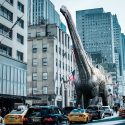Welcome to Jurassic World. In real life. Let’s bring back some of the most dangerous creatures to ever roam the Earth. What could go wrong? Right? How would we be able to clone dinosaurs? What would life with them roaming the Earth be like? And which ones would eat you for breakfast first?
In the book and subsequent movie saga of Jurassic Park, scientists find DNA from dinosaur blood preserved inside of a fossilized mosquito. Then, they clone a whole theme park’s-worth of prehistoric creatures. And, of course, all hell breaks loose. DNA is a vulnerable thing. It could be deteriorated by sunlight or water. So far, the oldest DNA discovered is one million years old.
If you want to clone dinosaurs, you’d need to find DNA at least 66 times older than that. Instead of waiting on the miraculous discovery of dinosaur DNA, let’s try something different. Like genetically reverse-engineering dinosaurs. You could take an animal that is alive today and work backward. Ok, going back through 66 million years of evolution wouldn’t be a walk in the park.
Genetically engineering a chicken to have teeth or a long tail wouldn’t exactly make it a dinosaur. But life, uh, finds a way. Now, if your dinosaur creations somehow escaped your maximum security lab and began living in the wild, you should be ready for trouble.
With over 700 different dinosaurs species discovered worldwide, you’d have to figure out which of them would be the safest to share the planet with and which ones would pose a serious threat. And you’d have to figure that out the hard way.
They would breed on their own. They would be hunted for sport. Or for meat. Maybe even kept as pets. And then, there would be a Tyrannosaurus rex on the prowl for you. No, not specifically you. Humans in general. People would spend less time outdoors out of fear of velociraptor attacks. Jobs requiring travel would become infinitely more dangerous.
Do you want to be driving an 18-wheeler with one of these things running across the highway? Travel would also be more expensive because of extra security precautions. Delays and cancellations would be common due to the flight patterns of pterodactyls. Food supply chains would be disrupted, as cattle and other livestock would be prime targets for predatory dinosaurs.
These creatures never had mammals to snack on in the past. Ranches and farms would be like a buffet to them. Massive herbivores like sauropods would struggle to meet their dietary needs. Plants that currently exist wouldn’t be the same as those millions of years ago. Sauropods wouldn’t have teeth, jaws or digestive systems adapted to eating the grasses that are common today.
Other animals and living things would need to adapt to the new predators on the block. Dinosaurs would be the ultimate invasive species. And their presence could cause extinction events for some of today’s species. It wouldn’t be a bed of roses for the dinosaurs, either. Unless they were engineered to be adapted to our modern-day global environments and climate, they would struggle too.
During the Cretaceous period, the atmosphere had 14% more oxygen than ours does today. For dinosaurs, it would feel like they were suddenly living at a Mount Everest base camp. If you could bring dinosaurs back, you’d be facing a major ethical dilemma. Mother Nature wiped them out. Reintroducing them for pure entertainment would be a hard case to win against scientists pushing for further conservation efforts.
Especially if you’d be planning to open your very own Jurassic Park. Lots of people would want to enjoy the dinosaurs in a zoo-like setting. You could stand to make a lot of money. So you’d likely have more luck convincing people if you stick to research purposes. You could do it to further cloning technology, or to verify findings and theories based on fossilized remains. Maybe you’d be better off bringing back an animal that became extinct because of humans.
Sources
- “Could We Build A Real-Life Jurassic Park?”. Ailsa Harvey, How It Works magazine. 2021. livescience.com.
- “Ultrastructure of 40-Million-Year-Old Insect Tissue”. George O. Poinar Jr. and Roberta Hess.1982. science.org.
- “Could Scientists Bring Dinosaurs Back To Life?”. Emily Osterloff. 2022. nhm.ac.uk.
- “How close are we to being able to reconstruct the DNA of long-extinct creatures–dinosaurs, for instance? What kinds of technical hurdles do we need to overcome, and do the recent advances in cloning bring us any nearer to the goal?”. 2022. scientificamerican.com.
- “Could A Dinosaur Survive In Today’S Climate Conditions? | BBC Science Focus Magazine”. Luis Villazon. 2022. sciencefocus.com.



























